A seamless payroll process is ensured by the Odoo 18 Payroll module, which assists in managing job entries and conflicts. Businesses can prevent mistakes that might compromise financial accuracy and employee satisfaction by seeing possible disputes and resolving them. We'll explore the features and capabilities of the Odoo 18 Payroll module in this blog article, with an emphasis on efficient job entry and dispute management.
The Value of Work Entry
The foundation of any payroll system is work entries. They serve as the main source of information used to calculate salaries, overtime, and other payroll components by keeping track of employees' hours, responsibilities, and schedules. Work entries and the payroll module are carefully integrated into Odoo 18, offering a smooth payslip, attendance, and vacation management experience.
1. Correct Payroll Estimates
The foundation of precise wage calculations in Odoo Payroll is work entries. They perform as a log of an employee's real hours worked, paid time off, absences, and other time-related elements that affect pay. The system cannot calculate the exact amount to pay or deduct without accurate work records, which could result in payroll problems and unhappy employees.
2. Combining Time Off and Attendance
Work entries are effortlessly integrated with other HR modules, such as Time Off and Attendance, by Odoo Payroll. By automating the computation procedure, this integration guarantees that time-related data enters payroll immediately from authorized leaves and attendance records. HR managers thereby minimize the possibility of human error and save time by reducing manual data entry.
3. Requirements for Legal and Compliance
In order to maintain legal compliance, work entries are essential. Employers are required by labor laws in many jurisdictions to keep accurate time records for auditing and dispute settlement. Work entries in Odoo offer a transparent and traceable record of working hours, overtime, and leaves, which can be used to prove compliance in audits or inspections.
4. Making Payroll Batches Easy
Work entries make it possible for payroll batches to be generated efficiently while managing payroll for several employees. They assist Odoo group workers according to their work schedules and guarantee that all relevant wage regulations are applied consistently. HR teams can now process payroll at scale without losing important data thanks to this.
5. Efficiency and Automation
Operational efficiency is increased by the automatic generation of work entries in Odoo based on contract parameters and scheduling. By automating monotonous operations, HR professionals may concentrate on more strategic endeavors. In order to maintain consistency, the system can also automatically produce work entries in the event that schedules or contracts are modified.
6. Foundation for Benefits and Salary Regulations
Odoo's salary regulations frequently rely on particular factors like overtime, leave types, and worked days. The raw data required for these rules to operate properly is provided via work entries. For instance, information taken straight from the work records is used to compute overtime bonuses or absence deductions.
7. Openness and Employee Confidence
The transparency that work entries offer is advantageous to employees. Through the Odoo Employee Portal, they may see their own work, leave, and attendance records. Because workers can check their work records and understand how their salaries are determined, this transparency fosters confidence.
8. Crucial for Analysis and Reporting
In Odoo, work entries are essential for producing thorough payroll reports. Workforce planning and policy changes can be informed by HR departments' analysis of absenteeism, overtime, and leave usage statistics. These insights assist businesses in maximizing output and cutting expenses associated with wages.
Handling of Conflicts
Inconsistencies or overlapping data entries that obstruct accurate employee payroll processing and calculation are referred to as conflicts. Records of an employee's working hours, leaves, or other time-related entries that overlap or are inconsistent may give rise to conflicting work entries in the Odoo 18 Payroll module. Strong capabilities for recognizing and addressing these problems are offered by Odoo 18.
To analyze conflicts on the Work Entry homepage in a Gantt chart, we can select and control the Conflict work entries option from the "Work Entries" menu.
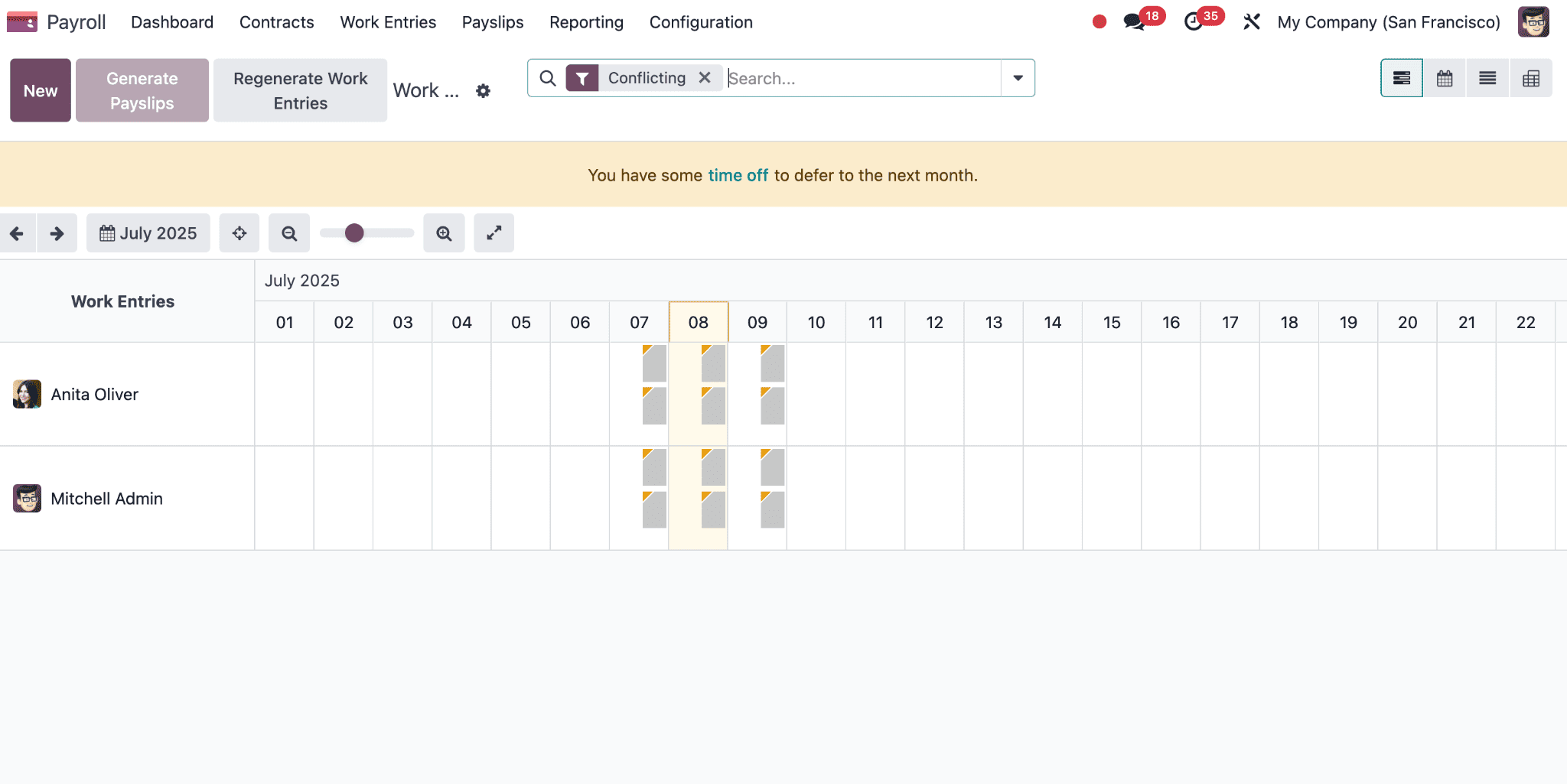
The recently marked conflict work entries can be viewed as follows by applying the Filters section of the advanced search bar's "Conflicting" option to the work entries.
To update and settle disputes using the "Work Entry Regeneration" form, click the "Regenerate Work Entries" button. Click "Regenerate Work Entries" after making any necessary adjustments to the "From" and "To" dates.
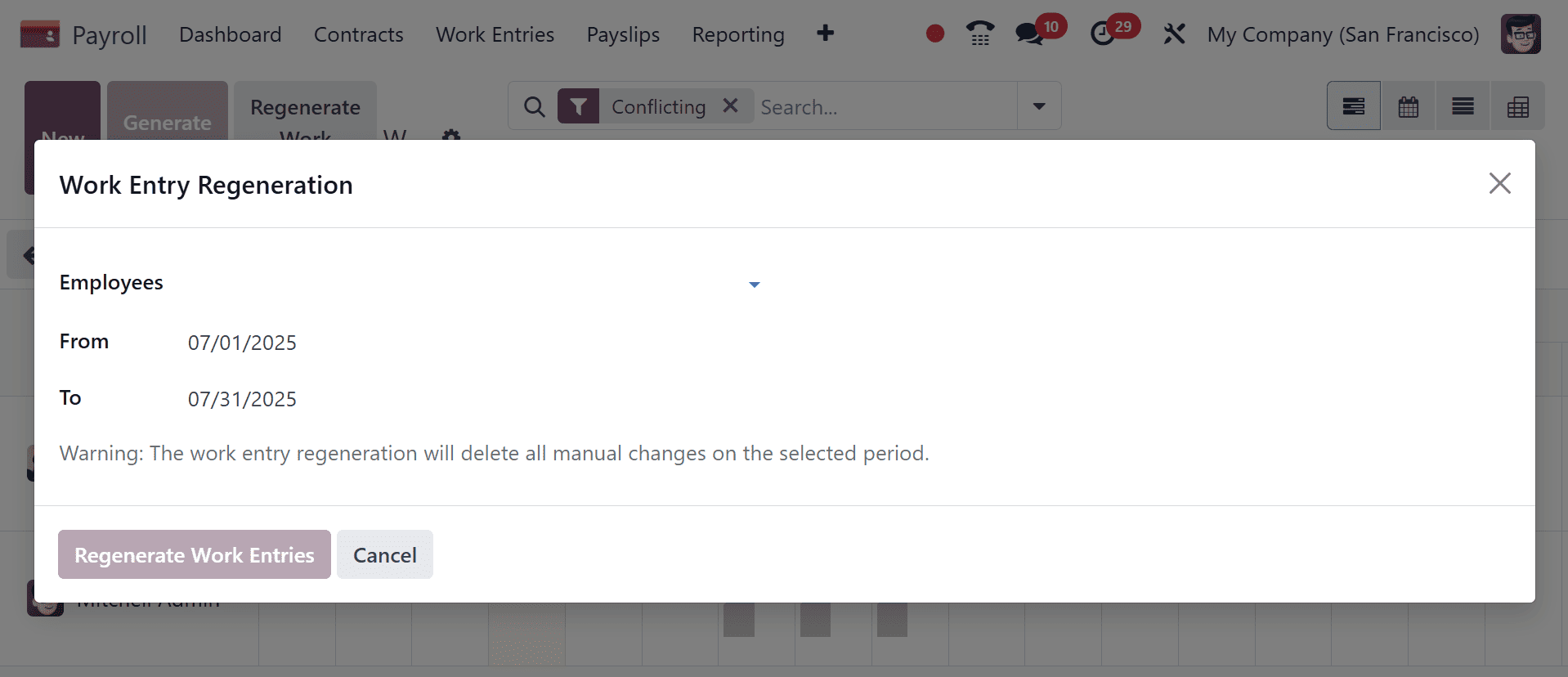
After work entries have been regenerated, evaluate them to resolve any disagreements, and if there are still any, review them again to address any discrepancies.
The screenshot below shows that the work entry regeneration is complete and that employee Anita Oliver's conflict issue has been removed from the Conflicts dashboard.
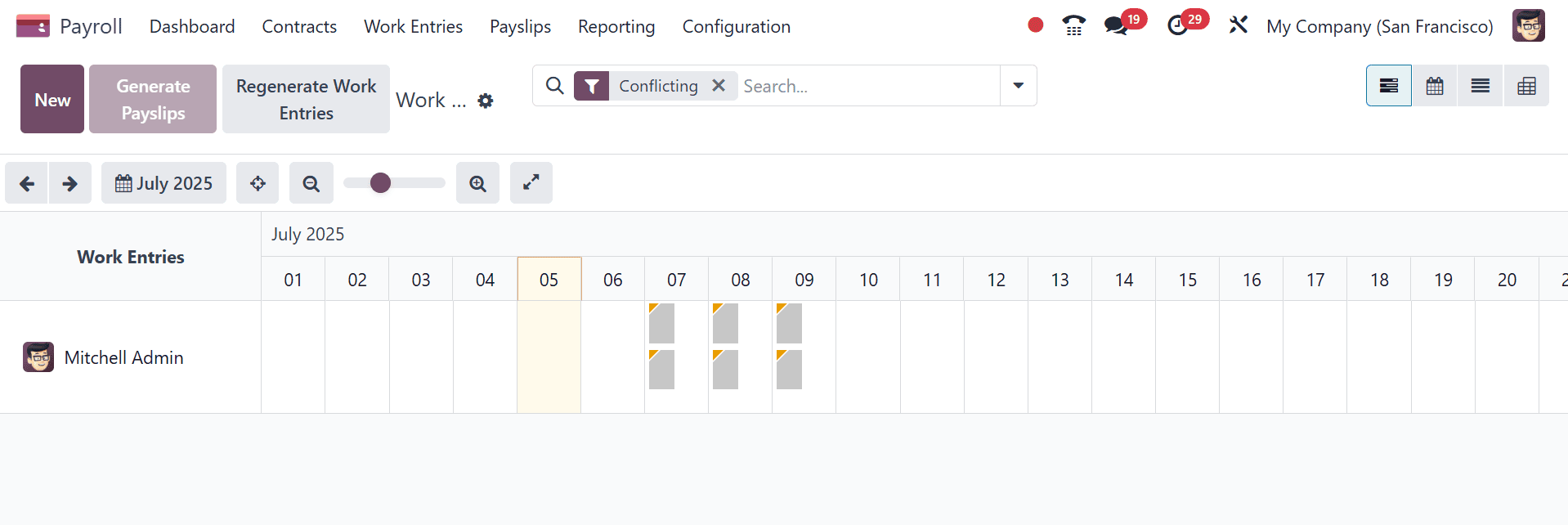
To create a new dispute entry, click the "New" button to open a form. Set the dates and duration as indicated below, and enter the required information, such as the employee's name and the type of work entry.
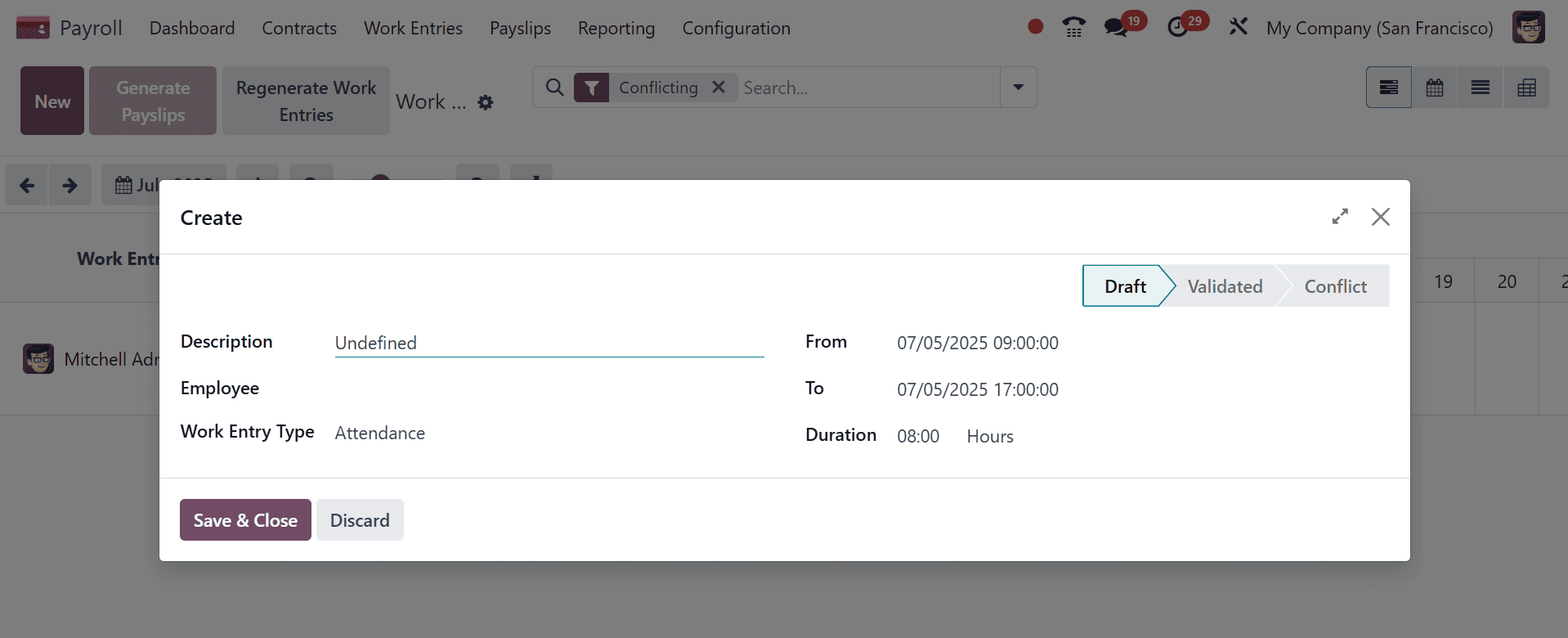
To save the updated conflict entry, click "Save & Close" at the end. Additionally, the "Conflicts" dashboard allows us to handle these conflict entries.

Creating New Work Entry
When removing the default filter ‘Conflicting’, the Gantt chart view is used to display work entries, and it can be tailored to display entries by day, week, or month.
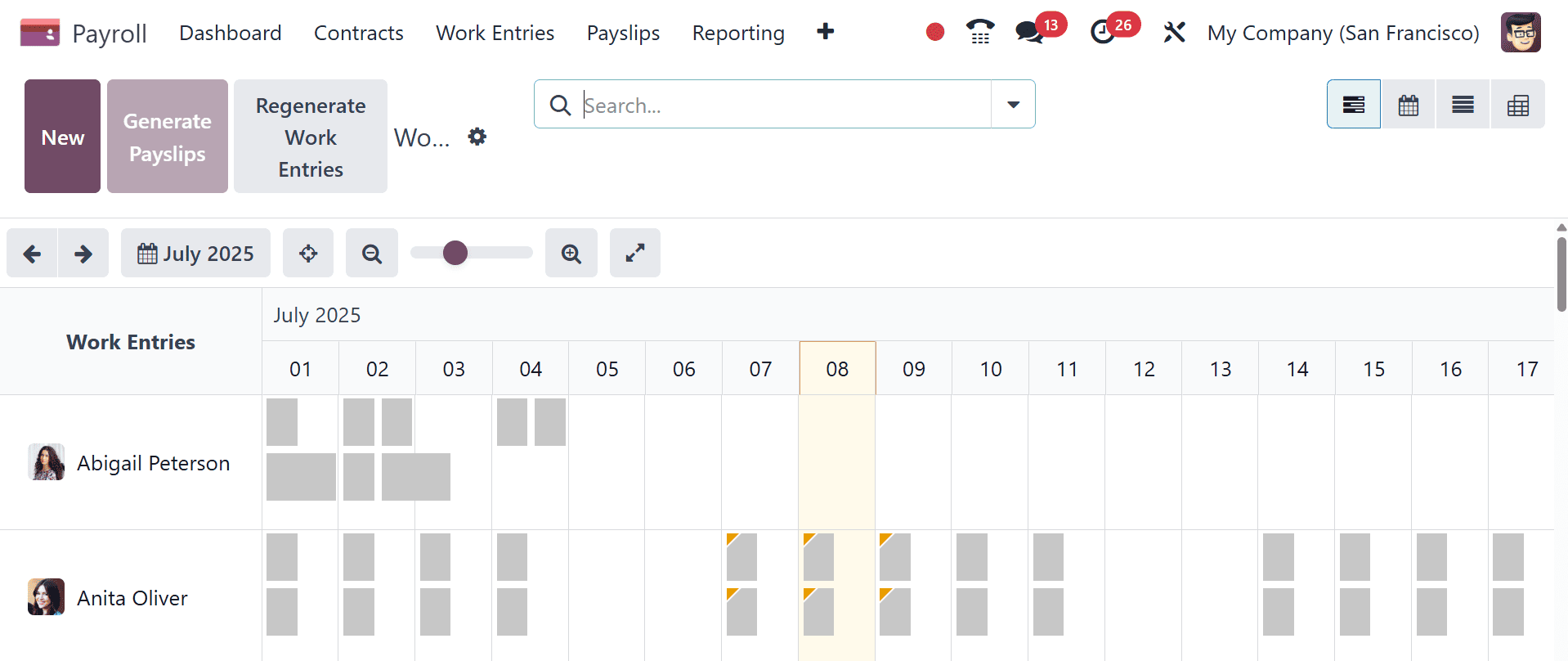
To create a new entry, click the "New" button to bring up a popup window. Enter the required information, including the start and end dates, the employee's name, the work entry type (such as attendance, paid time off, or sick time off), and the description. The work entry's duration is automatically determined.
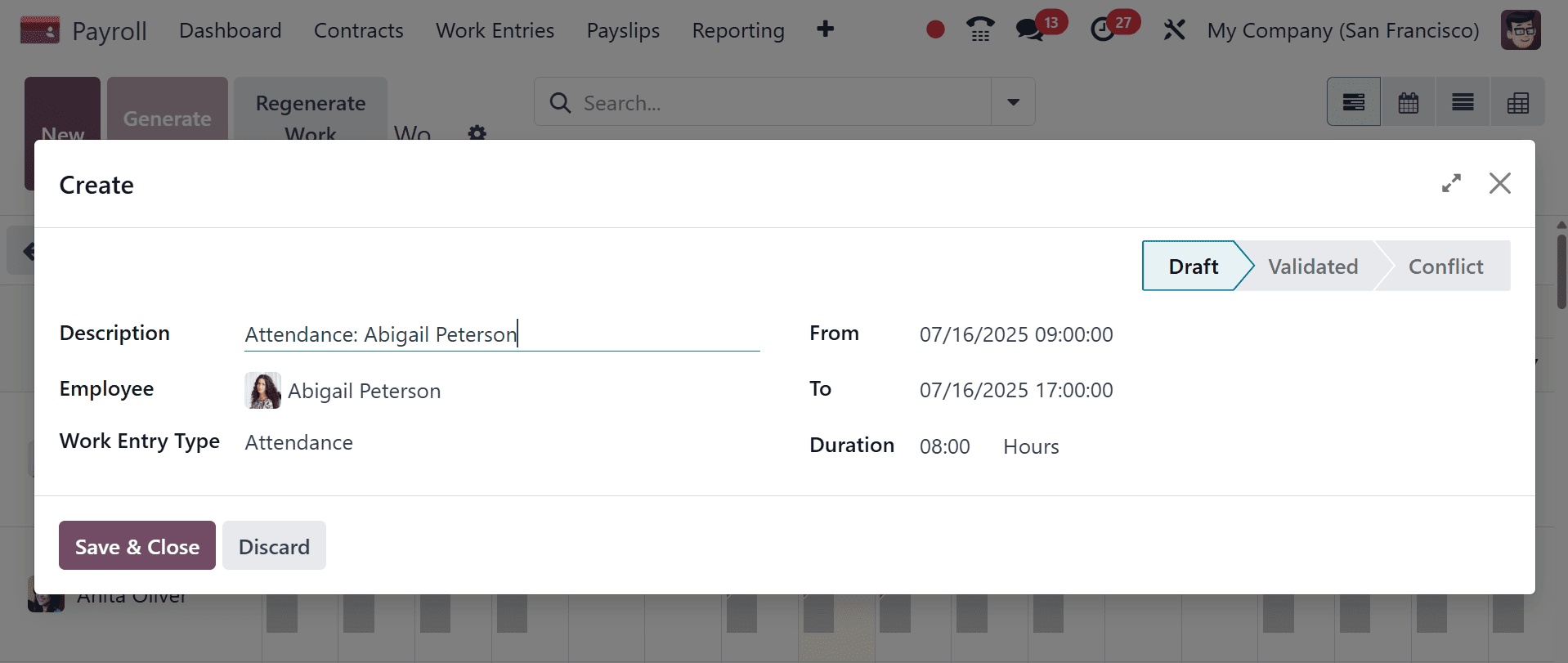
Click "Save & Close" to save the work entry once all the information has been entered. At the top of the window, the entry's status—Draft, Validated, or Conflict—is shown.
Users can manage or remove entries by clicking on the appropriate context, view and edit entries, and add new items using the "+" symbol on the dashboard.
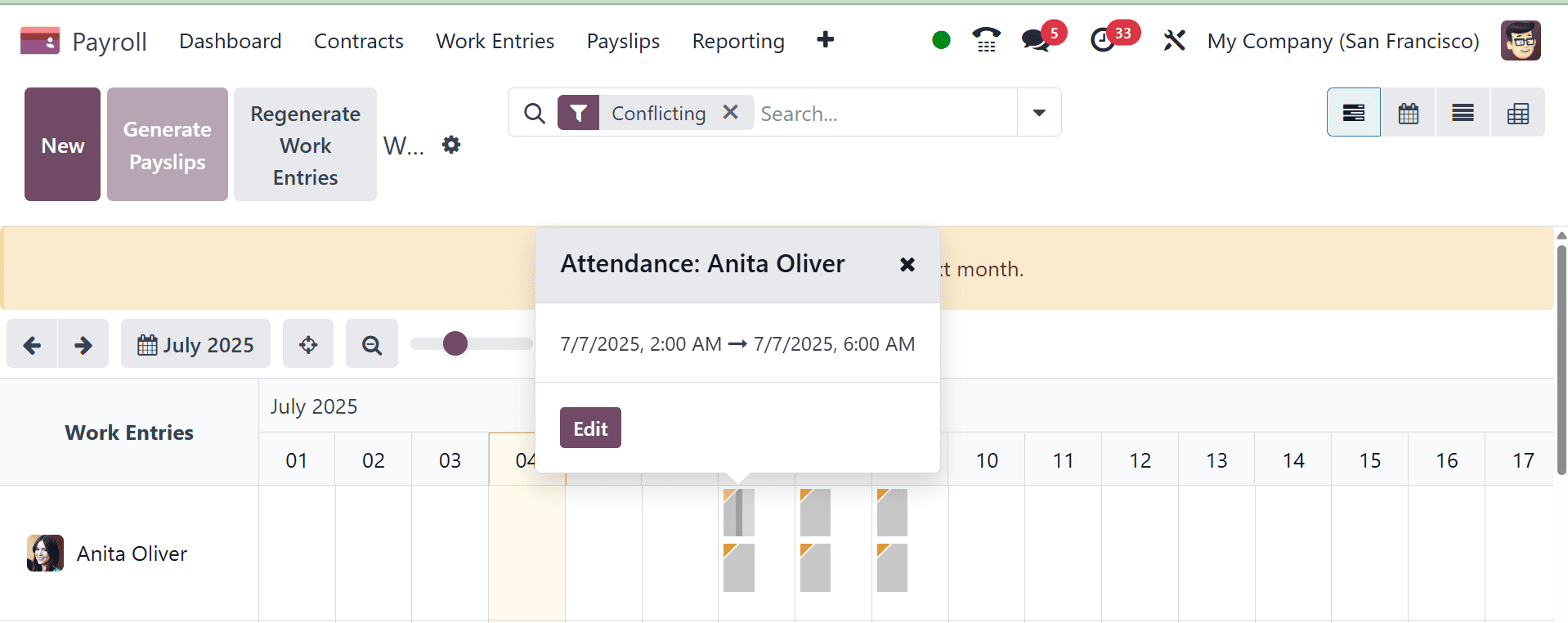
Now, let us look at work entry generation based on work schedules, attendance, and planning. Work entries are produced automatically using information about employee scheduling, attendance, and time off data. Each employee's work entries are shown visually on the Payroll app's Work Entries dashboard. Paystubs are then computed and produced using these work entries. The "Work Entry Source" option in the Payroll application of Odoo's employee module controls how work entries are created for employees. "Working Schedule" and "Attendance" are the two primary options. Work entries are generated according to the employee's predetermined work schedule if "Working Schedule" is chosen. Work entries are generated using the employee's attendance records, which are normally recorded using the Attendances program, if "Attendances" is chosen.
For that, go to the Employee module and select a specific employee contract from the list.
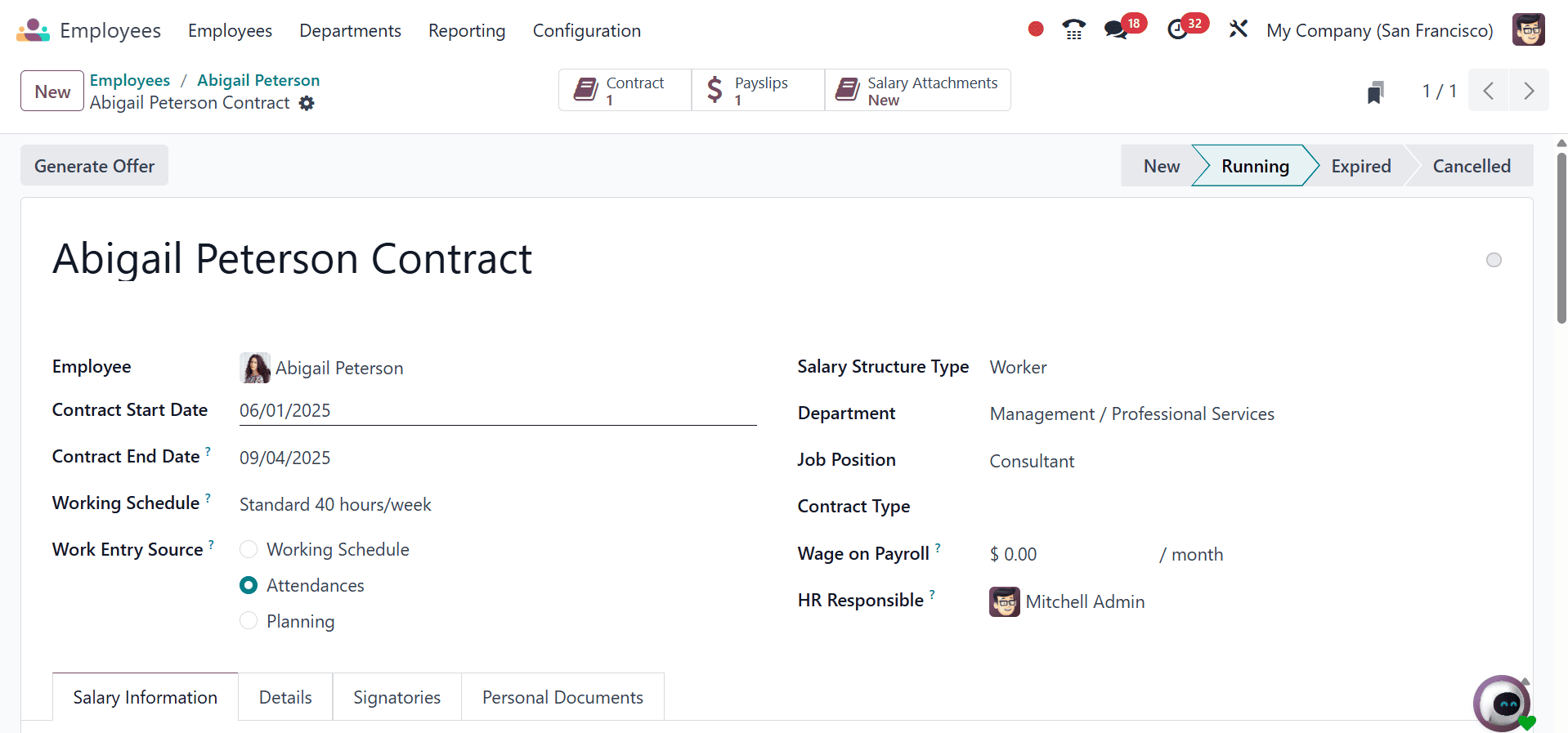
Here, you can view all the details regarding the employee. Then, to give the salary based on attendance, go to the Attendance module.
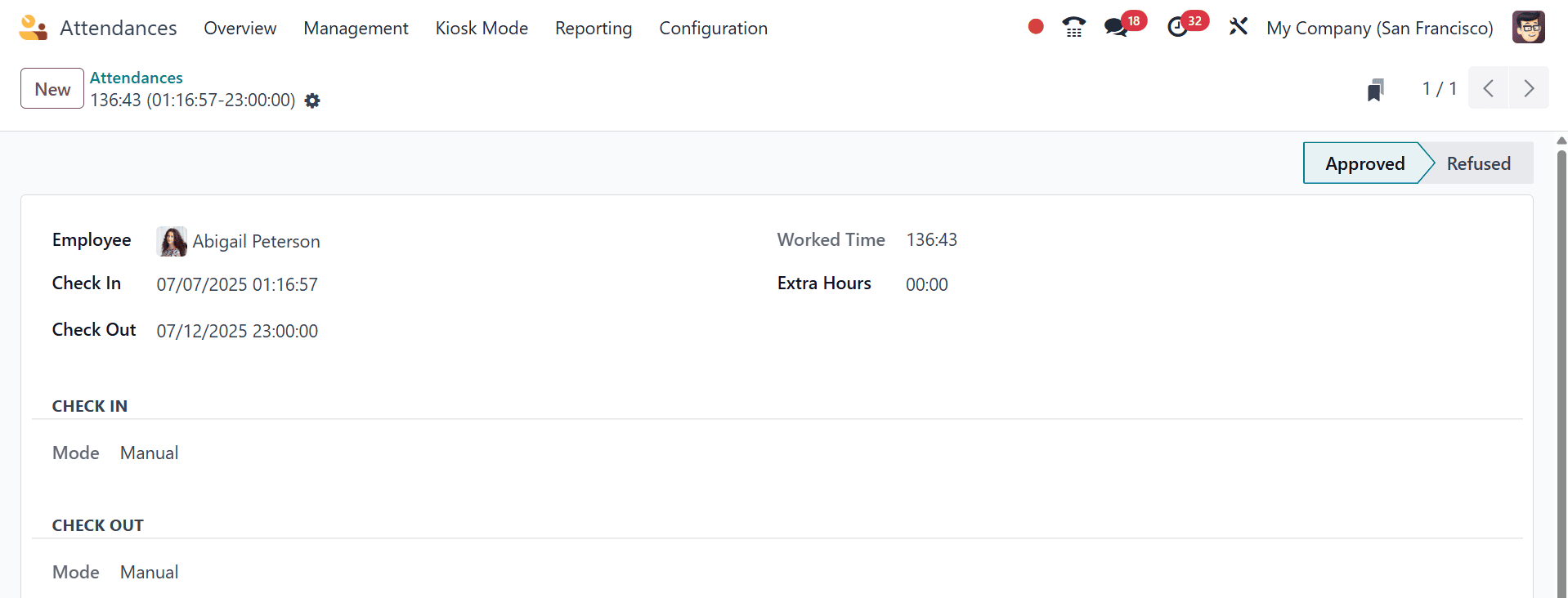
Now, to create a payslip for the employee, go to the payroll module, and there, select the To Pay option. There, select the created employee as in the screenshot below.
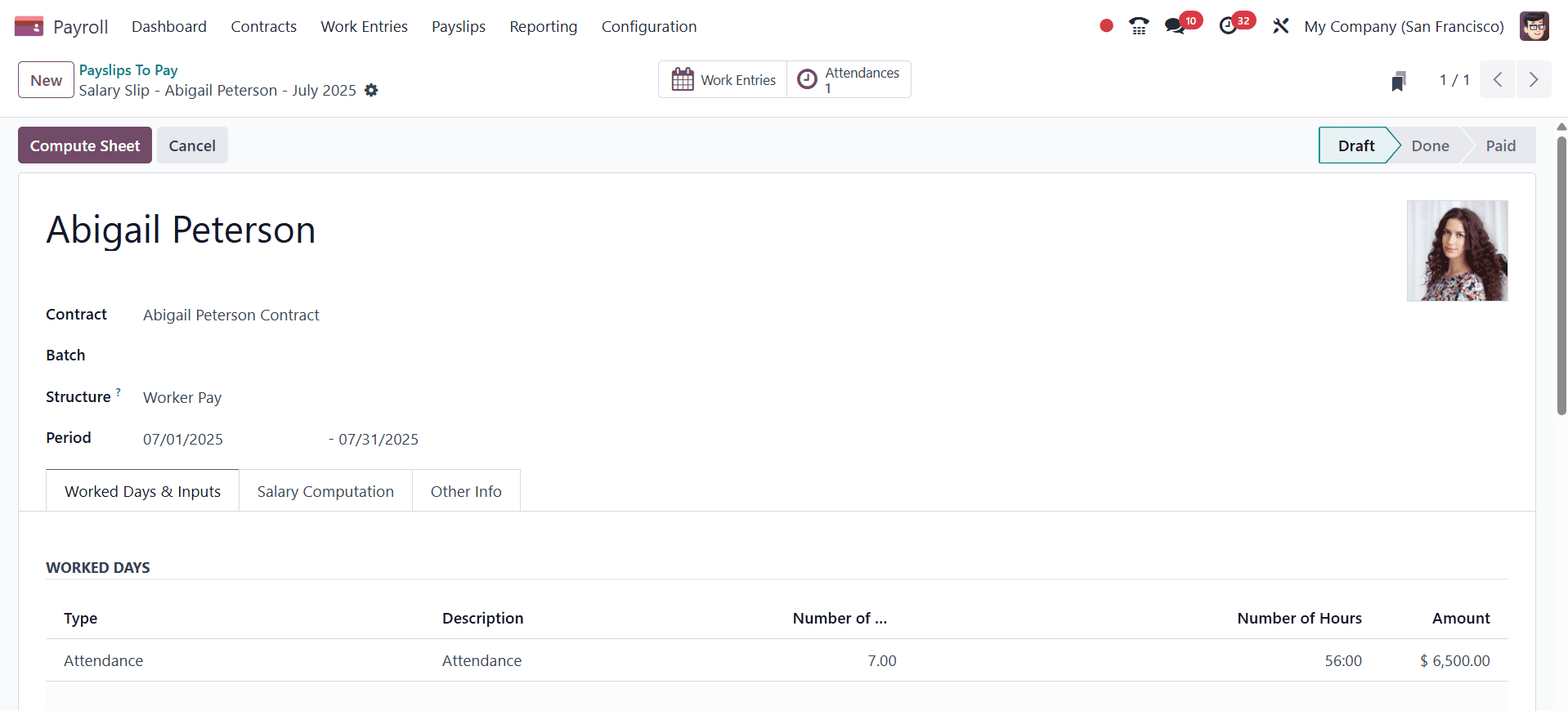
Then, from there, go to the Attendance smart icon shown in the top of the page, which shows the attendance marked for the employee.

Then, go back to the salary slip page and complete the salary. Then, the attendance imported work entry will be generated for the employee, as in the screenshot below.
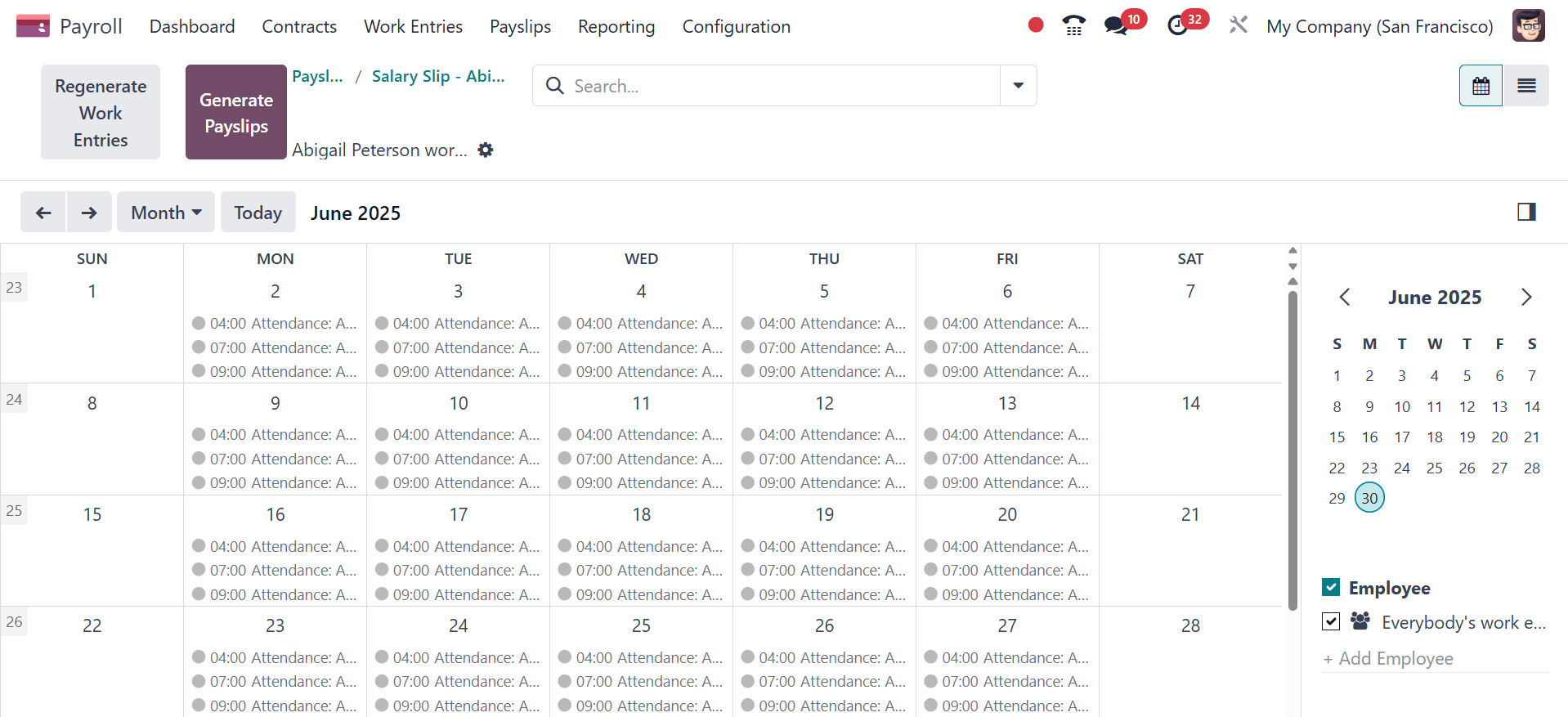
To create a payslip for this, go for the Create a Draft entry option and make the payment process complete for the employee.
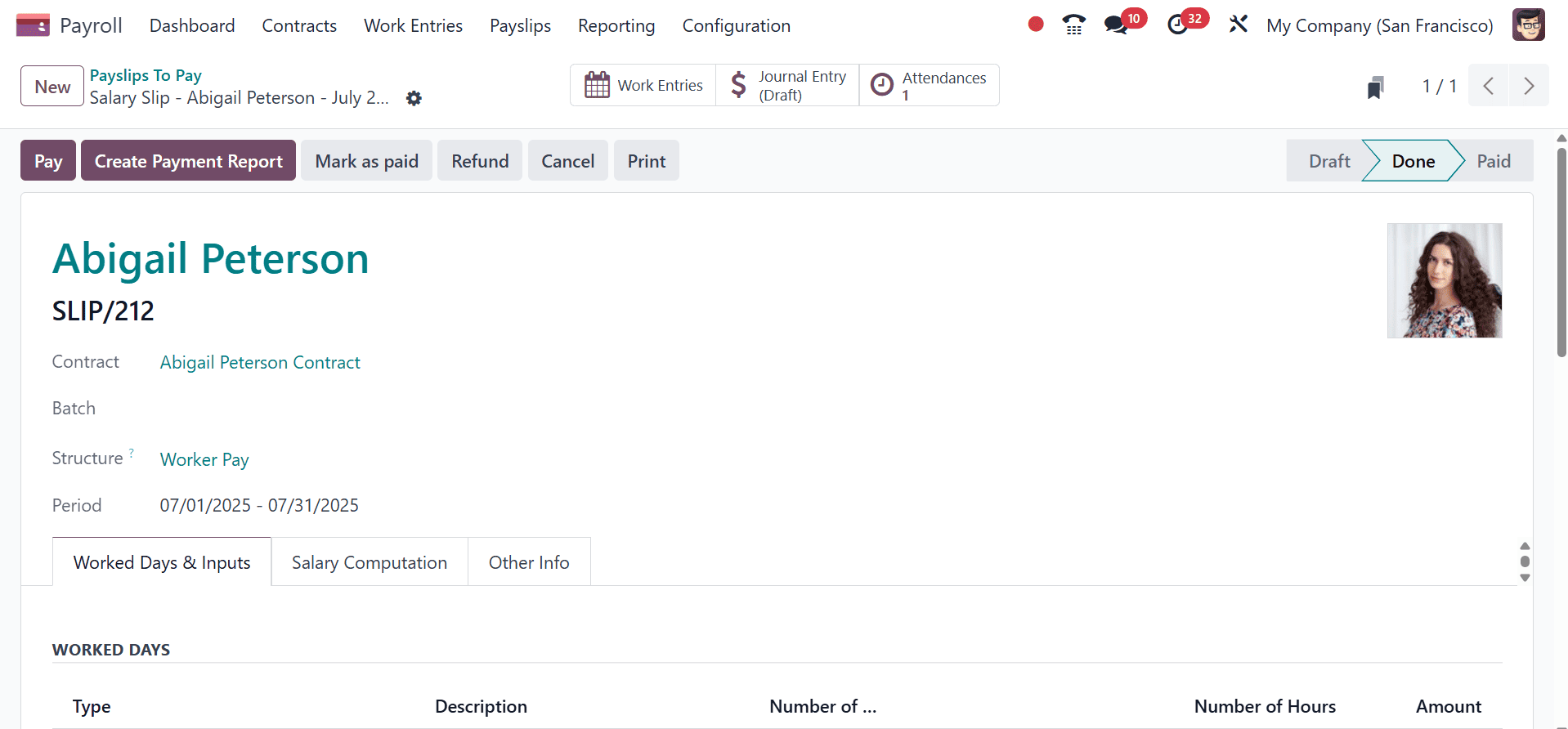
By controlling job entries and conflicts, guaranteeing precise processing, and lowering errors, Odoo 18's Payroll module streamlines payroll administration. It increases a payroll system's overall efficiency, streamlines operations, and lowers errors.
To read more about How to Configure Work Entries & Conflicts with Odoo 17 Payroll, refer to our blog How to Configure Work Entries & Conflicts with Odoo 17 Payroll.